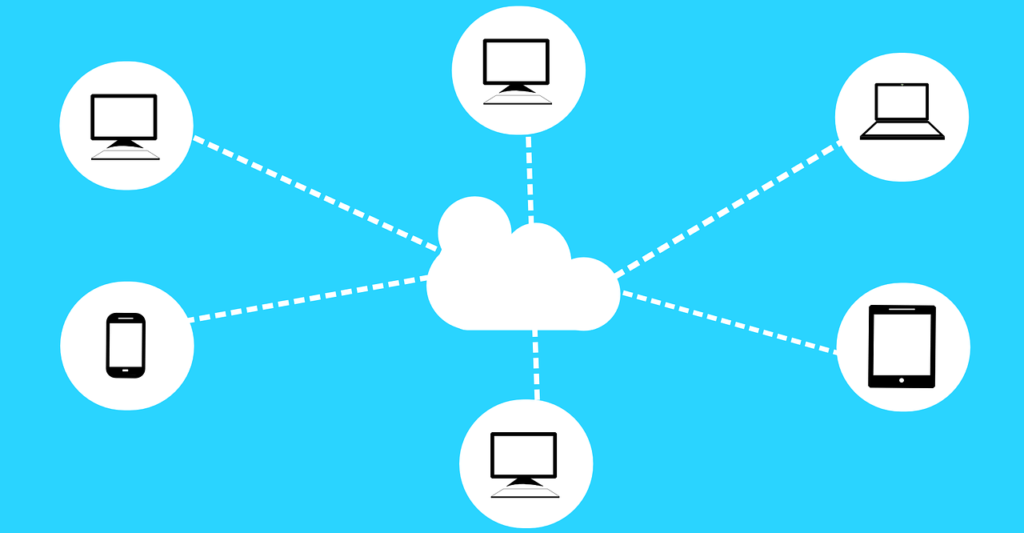
We’ve heard a lot about the cloud in recent years. It has rapidly become an integral part of the technological revolution that, in turn, has had such a far-reaching, transformative impact on how we do business with one another. From choosing an online phone service to processing and understanding big data, this technological revolution shows few signs of flagging. So, one of the key questions facing businesses in the years ahead is how to position themselves so that they can take advantage of the opportunities the cloud provides.
One thing that is clear is that firms which fail to take account of the pace of technological change risk falling well behind their nimbler rivals. A cloud-first strategy is therefore essential simply to keep up. Firms from globe-straddling multinationals to small and medium-sized enterprises (SMEs) have invested significant amounts of money into cloud technology like scheduling software. As a result, they’re already reaping the rewards. If your business hasn’t done the same, then, you can’t afford to hang around for much longer.

What complicates matters, however, is that many businesses are still running on the back of an outdated technological infrastructure. It’s easy, of course, to become somewhat set in your ways as far as technology is concerned. Introducing new technologies is an expensive and often resource-hungry process. That means there’s always the temptation to carry on as before, for example, by continuing to use an old customer engagement platform beyond its sell-by date. But customers’ expectations are constantly changing, and they’re becoming more demanding all the time. This is something you urgently need to take into consideration.
So, with all this in mind, you need to start thinking about how to take your business onto the cloud. This will involve a process known as cloud migration. If you’ve never come across this term before, don’t worry – it’s pretty self-explanatory. Here, we’ll start by introducing you to the concept of cloud migration and explaining what it means. Then, we’ll go on to outline a number of top tips to help you with the process, ensuring that it runs as smoothly as possible. Read on, and find out more.
What is cloud migration?
It’s always good to start with the basics. Cloud migration is, as the name might suggest, the process by which firms transfer their operations to the cloud. Think of it like moving from a small office to a bigger one. Such a move would involve physically relocating computers, peripherals, cabinets, files and so on (not forgetting all your office trinkets and those pictures of the cat on your desk, etcetera).
Cloud migration doesn’t involve any physical moving around, but otherwise it’s similar. What’s being moved around in this case are data, systems, and applications, and they’re being moved between data centers.
You might be wondering at this point what the exact advantages of cloud migration are. In fact, there are many of them. The most obvious potential benefit of cloud migration is that it can deliver significant cost savings. In a world when business overheads are always a key consideration, cloud migration can allow you to free up financial resources that you can then redeploy elsewhere. Or, finance you might use to provide your business with some valuable breathing space.
Migrating IT operations to the cloud tends to be much cheaper as it saves businesses from having to spend on maintenance and upgrades (which are handled by cloud providers). Other technologies such as edge computing, meanwhile, can also help firms make the most effective use of the cloud.

Another advantage of cloud migration is that it allows your business to overcome any reliance on outmoded legacy technologies. Legacy technology is again quite self-explanatory. It’s technology that is still being put to everyday use, but which has in fact been superseded by more modern solutions.
You might think that this isn’t a big deal as long as those old technologies are still doing the job. But the point is that they aren’t doing the job as well as it might otherwise be done. What’s more, older technologies are likely to become increasingly unreliable over time (especially as their manufacturers withdraw technical support for them). It’s in the best interests of your business, then, not to be overly reliant on such old tech.
Top tips for a smooth cloud migration
Now we’ve clarified what cloud migration is and why it’s a very good idea for your business, it’s time to discuss how to go about it. As with any technological upgrade, there’s a lot to think about before pressing ahead with any cloud migration. There’s always a fair amount that could go wrong. For that reason alone you need to be conscious of these potential pitfalls, and have a plan for avoiding them. Here are our four top tips:
1. Plan your migration in advance
Cloud migration has a lot of potential upsides from which your business could benefit, but it’s a big undertaking. As such, everything needs to be considered very carefully in advance. Don’t go charging into anything, as you’ll probably live to regret it. It’s the same as anything else in business – whether it’s a major tech upgrade or something as simple as an audio conference call – if you haven’t done the requisite preparation, you won’t get the benefits you were hoping for.
Before ploughing ahead with your cloud migration, then, you need to have a clear idea of what your objectives are and how to achieve them. Think about your budget: how much is all this going to cost? What are the likely financial benefits you can expect as a result of your cloud migration? Do those benefits outweigh the likely cost? The cost of cloud migration will obviously depend on the nature of the migration itself, and Covid-19 appears to be having an effect on cloud migration costs. Which systems and apps are you looking to transfer to the cloud?

Furthermore, you need to think about the potential disruption the migration process could cause to your everyday business operations. Will the migration require system downtime, and if so, how will this affect your ability to provide your customers with a regular service? What steps can you take to shift resources around so as to minimize any disruption?
If you can’t avoid disruption to customer service altogether, then you need to consider how and when to inform your customers about how they’ll be affected. Perhaps offering a live chat service could help them get the information they need?
A crucial point to remember about cloud migration is that it’s not a matter of simply flipping a switch and hey presto; you’ve migrated everything to the cloud. It is inevitably a substantial project. Nevertheless, by planning your migration thoroughly in advance, you can implement the migration at a speed which suits your business. That will allow you to balance the requirements of keeping systems operational with getting the migration done in a speedy and efficient manner.
2. Adopt a strategic approach to implementation
When undertaking a cloud migration process, you need to think strategically. We’ve talked already about the questions you’ll need to ask yourself when undertaking the initial planning stage. Once you’ve resolved those to your satisfaction, you can then start to think about the implementation phase. It goes without saying that this comes with all sorts of potential snags. There’s the potential for major disruption, then, if you don’t approach your cloud migration in the appropriate way.
A strategic approach to cloud migration can help to reduce the risk of avoidable disruption while the process is ongoing. But don’t assume that you can just pluck a standard model off the shelf and proceed like that. It’s absolutely vital to remember that there’s no one-size-fits-all solution to cloud migration. You need to incorporate the specific needs of your business into your cloud migration strategy, and ensure that everyone involved fully understands the nature of the undertaking. What applications and infrastructure will be involved in the migration process? A thorough appreciation of this can make the whole migration much smoother than it otherwise might be.

Take it one step at a time. Start by considering what tools you’ll need: these will include migration servers, analytics, content services connectors, and various user tools. Your toolkit must be in line with your requirements during the migration process, offering suitable scalability and integration with third-party tools, and enabling you to undertake the necessary auditing, discovery, migration, and validation of data.
Once you’ve got your migration toolkit in place, you must ensure that you have both the right people to do the job and a rock-solid migration process in place to monitor outcomes. As far as your process is concerned, the key focuses must be risk mitigation and maximizing efficiency. We’ve already noted how cloud migration – like any process involving technology – can be prone to disruption and inefficiencies. This is why you need to make sure that the people overseeing the migration have a proven track record of effective delivery in previous projects. Your process, meanwhile, must have clear objectives in place, as well as a team with the requisite skills and capacities to meet them.
3. Migrating content
The central aspect of cloud migration is migrating content. This is, needless to say, a substantial challenge for any firm – whether an SME or a huge corporation. Businesses are dealing with huge numbers of documents all the time, and it’s not until you come to migrate some of them that you realize just how large this burden is. So, before you start migrating to the cloud, you should think very carefully about what content you need to migrate, and whether there’s any you can afford to do without. This should help to make the process more efficient and less time-consuming.
You’ll have documents relating to all sorts of different things, from customer databases to SaaS products, and they’ll be scattered across all sorts of different places. How can you go about rationalizing this and migrating what you need in a practical manner? Undertake a thorough review of your content and consider whether you actually need to migrate all of it across to the cloud. The size of the migration will have an important bearing on the methods you use to complete it. Small-scale migrations can be completed with a reliable high-speed broadband connection, though for larger migrations physical appliances will be needed.

Once you’ve audited your content and worked out what you need to transfer and what you don’t, you can then go about deciding how you’re going to make the move. For a large-scale migration where physical equipment is required, the costs will obviously be that much higher. Smaller migrations over high-speed internet tend to be much simpler and cheaper. It’s a matter of striking the right balance between your business’s needs and the pressures on its budget.
4. Set a timeline – and stick to it
Technological projects are notorious for slippage. In other words, they have a tendency to plough through your budget and take longer than anticipated. This is why you must take pre-emptive steps to reduce the risk of any such slippage occurring. A clear migration timeline can help you keep the whole project on the straight and narrow. However, it’ll only do that if you make sure you stick to it! Your migration timeline should be an integral part of your overall migration plan.
When setting a migration timeline, it’s important to keep priorities uppermost in your mind. This is why you need to work out which content you’re going to migrate first. Content you’ve accessed recently should go first, with less recently-accessed content held back for later phases.
This helps to take some of the potential risk out of the migration process. It also makes it easier for you to keep your operations up and running, even while your systems and applications are undergoing cloud migration. Whatever you do, ensure that your timeline remains firm and robust. If targets and deadlines do start to slip, costs could start to balloon, thereby undoing many of the financial benefits you were hoping to secure.

Hopefully, this will provide you with some useful insights and helpful guidance about your planned cloud migration. This is just one way to help make your business more dynamic and efficient, but the benefits of the cloud don’t stop there: cloud-based technologies such as VoIP can make business more cost-effective, for example. But as we’ve discussed, the benefits from even modest levels of investment can be huge, and could potentially give you a crucial advantage over your competitors. Good luck!
Recommended articles:
How Cloud and SaaS are Accelerating the Digital Transformation of Companies
AWS vs. Azure Cost Comparison [2022]




